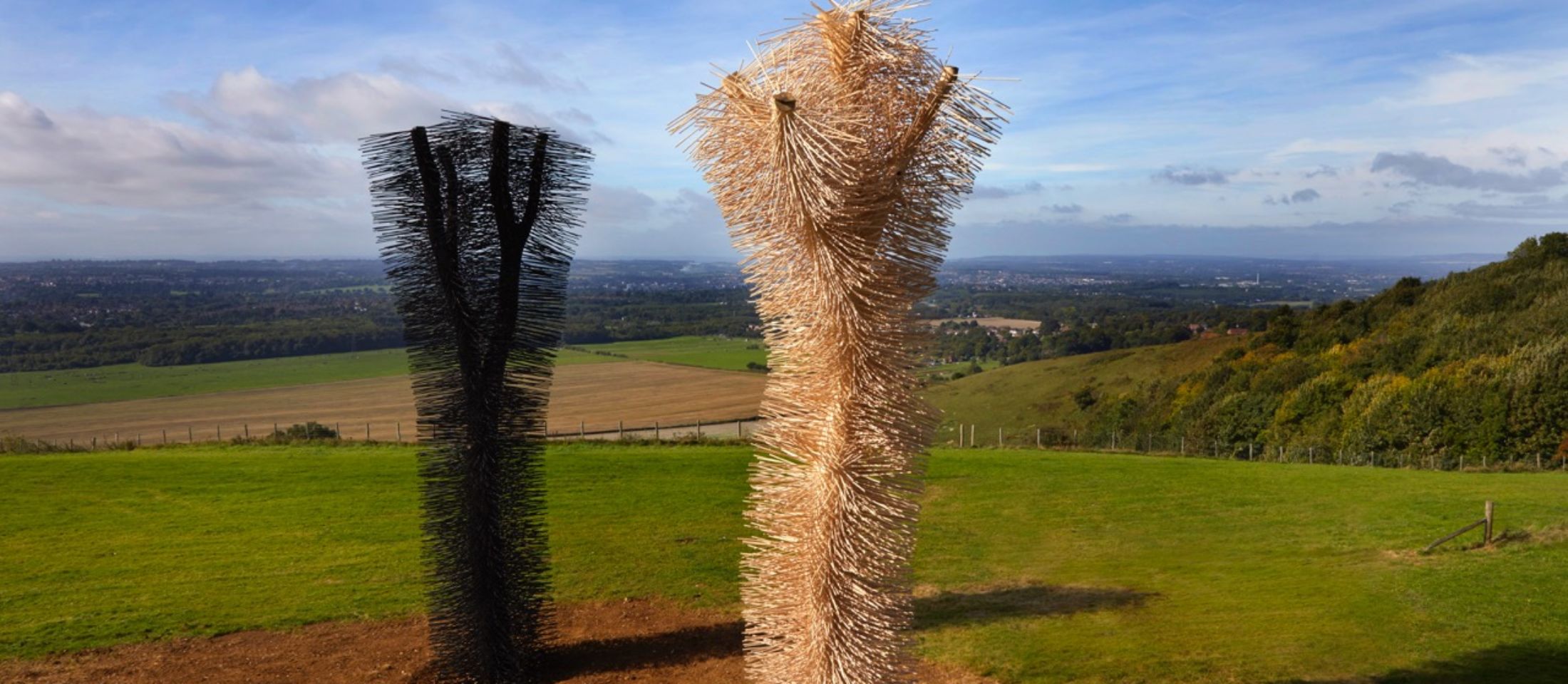
Ash to Ash, White Horse Wood, 2018. Photo Manuel Vason

Ash to Ash, White Horse Wood, 2018. Photo Manuel Vason
Processes of growth and decay are integral to our time-based art practice, and over the last ten years, living trees have featured significantly in our artwork. We say ‘living’ as previously we had often worked with found and fallen branches, trees that were burnt in forest fires or dead trees juxtaposed in unlikely environments, such as domestic rooms impregnated with seedling grass on walls. In 2007, we commenced a body of work with living trees by germinating acorns collected from Joseph Beuys’s seminal “7000 Oaks” artwork, and in 2015 completed History Trees, a series of ten large semi-mature trees holding huge engraved rings at the major entrances to the Queen Elizabeth Olympic Park.
When working with plant material we often catalyze the growth process by germinating seeds. The ash presents a distinct challenge given the pervasiveness of the fungal infection Hymenoscyphus fraxineus affecting millions of ash trees across the country and it is high likely vulnerable seedlings will succumb to infection. The Forestry Commission has embarked on research to identify the genetic factors that allow some ash trees to tolerate or resist infection, with a long-term view to breed new disease resistant ash trees for the future.
However, the current plight of the ash tree cannot be understated. Landscapes, fields, hedgerows, parks and gardens will be irrevocably changed as landmark canopy trees and copses of ash disappear. Equally, it cannot be understated the role the ash tree has played in the history, economies and ecology of the British Isles. It is a tree with a strong heritage and common touch that is described by Rob Penn, author of The Man Who Made Things Out of Trees, as “the timber of the working man.” He details the making and crafting of over 45 objects from a 130 year old ash tree felled in a forest close to his Welsh home, showing how the flexibility and strength of the wood has made it indispensable to tool makers, sportsmen, warriors and hunters.
Ash has featured and inspired both of our early art practice. Dan made arrow and pitched fork sculptures whilst studying at the Royal College of Art, and the tree was a formative influence on Heather’s emerging practice, inspiring her to work with plant material following a student workshop in the north Welsh countryside with artist David Nash just after he had planted the Ash Dome. Nearly forty years later, not even this most iconic of artworks is spared. Ash Dome is now afflicted. Nash expresses his acceptance of the hand of nature in the demise of his artwork, though reflective that he had always thought it would outlive him.
There is inevitable pathos in the loss of the ash. Rooted into both our landscape and psyche, mythologized as the World Tree by the Norsemen, that upheld the world of the gods, humanity and worms – the so-called “cosmic” tree is in deep trouble. Rob Penn writes, “It is the largest contributor to natural regeneration in British broad-leaved woodlands, accounting for more than 40 per cent of all observed seedlings and saplings in some surveys”, it grows fast in the right circumstances; on moist, lime-rich soil in woodlands ash is one of the most productive hardwoods, highly productive when coppiced – and when pollarded – yet its vigor and opportunism is being laid to waste by the fungal infection. As part of its strategy to resist infection, the tree’s defense mechanism produces epicormic growth – naturally occurring shoots which form along the main trunk and branches. The tree appears to be arming itself with a coat of spears.
The arrow is integral to our artwork. The arrow shaft is cleaved from ash. Straight-grained and clean, with an aerodynamic design it lent itself to one of the deadliest weapons in medieval European warfare, the longbow. History recounts the huge industry in arrow production between 1300-1500 and relays the unprecedented defeat of medieval armies by arrow-storms where English archers could unleash twelve arrows a minute. The arrow is light enough to shoot a good distance, yet heavy enough to maintain its high, initial velocity and cause damage when striking the target. Another key property ‘stiffness’ is, in material sciences the property of a structure, sometimes referred to as ‘dynamic spine’ by archers; if the arrow is ‘correct’ it can withstand the initial impulse of release from the bow.
In our artwork, stripped of feather flight and steel head it is impaled in its thousands into the monolith form of two ash trees. A monolith describes a pollarded tree, where major branches are truncated. One tree is stripped of bark, pale and smooth. The other tree is burnt dark ash. Both trees standing vertically, up to 10m high have their natural forms extended by the extruding mass of arrow shafts. The arrow mass creates an aura, where natural light will add a shifting dimension of interplay between sunlight and shadow. The two forms with their truncated arm branches assume an anthropomorphic presence; they seem to mirror each other, yet one casts a dark shadow of loss. In Homer’s epic The Iliad, Achilles’ spear is made of ash and on his death became a talisman, which allowed entrance and exit to and from the Underworld.
Visit the sculpture
Read about the research and development project
For over 25 years, Ackroyd & Harvey have exhibited in contemporary art galleries, museums and public spaces worldwide; sculpture, photography, architecture, ecology and biology intersect in their work, revealing an intrinsic bias towards process and event. Often reflecting environmental and scientific concerns, they are acclaimed for large- scale interventions in sites of architectural interest. Their work inspires viewers to think differently about their relationships to space and environment. Recent commissions have traced species loss across the globe. In 2012 they produced History Trees across the Olympic park recording the histories of the sites excavation.